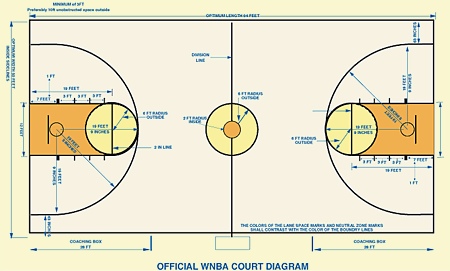Home »
Misc »
How big is an official basketball court
How big is an official basketball court
Basketball Court Dimensions & Markings
The playing area of a basketball court in the UK is 91.8ft (28m) in length and 49.21ft (15m) wide. Indoor courts should be 22.96ft (7m) in height.
Sport England's requirements are split into four levels of play: International, Premier (national competition), Club (regional competition) and Community (schools/recreational). This allows courts to be more flexible with sizes. The dimensions of a basketball court in these cases also include a minimum length and width: 85.3ft (26m) x 45.93ft (14m).
| Court aspect | Dimensions |
| Length (International) | 28m |
| Width (International) | 15m |
| Height (International) | 7m |
| Length (other levels) | 26-28m |
| Width (other levels) | 14-15m |
| Height (other levels) | 7m |
How long is a basketball court?
The length of a basketball court is 28m.![]() These measurements can be reduced to 26m for Premier, Club and Community courts where only smaller spaces are available.
These measurements can be reduced to 26m for Premier, Club and Community courts where only smaller spaces are available.
How wide is a basketball court?
The width of an International-standard basketball court in the UK is usually 15m. The court lines can be reduced by no more than 1m (14m) if required for lower levels of play.
What is the total area of a basketball court?
The total area of a professional basketball court is 420m². The minimum area allowed under Basketball England's guidance is 364m². These measurements apply to both indoor and outdoor courts.
The addition of 2.05m run-offs and 2m for teams and officials on the sideline increases the total area to 677.31m².
Basketball court dimensions in feet
A basketball court is 91.86ft long and 49.21ft wide. The total playing area for a court is 4520.43 ft² and 7290.5ft² if run-offs and sidelines are required.
| Court aspect | Dimensions |
| Length | 91.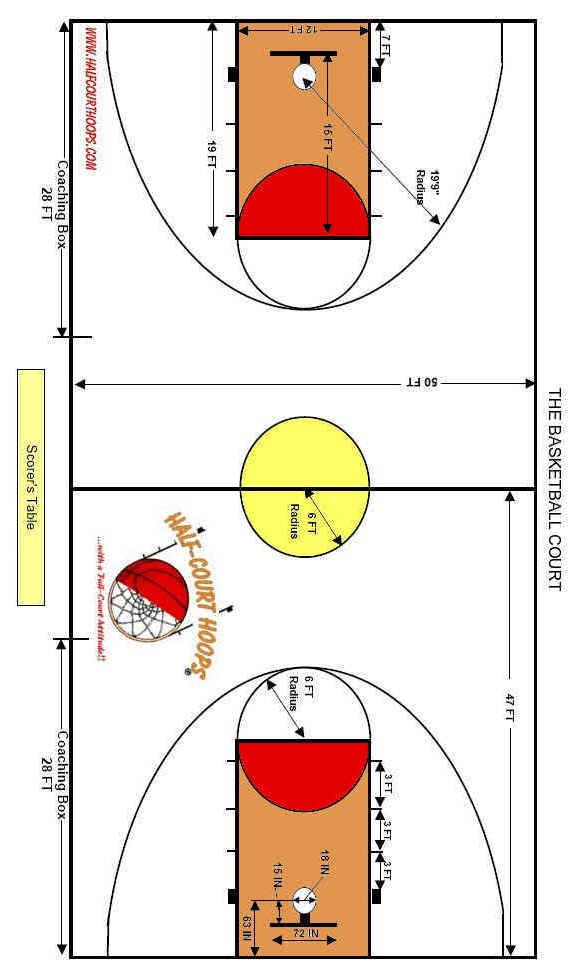 86ft 86ft |
| Width | 49.21ft |
| Height | 22.96ft |
| Playing area | 4520.43ft² |
| Playing area (including run-offs and sidelines) | 7290.5ft² |
Basketball court dimensions in yards
A basketball court is 30.62 yards long, and 16.4 yards wide. The total playing area for a court is 502.31yds² and 810yds² if run-offs and sidelines are required.
| Court aspect | Dimensions |
| Length | 30.62yds |
| Width | 16.4yds |
| Playing area | 502.31yds² |
| Playing area (including run-offs and sidelines) | 810yds² |
Basketball court markings
Regulation line markings must be 50mm width in a contrasting colour to the playing surface.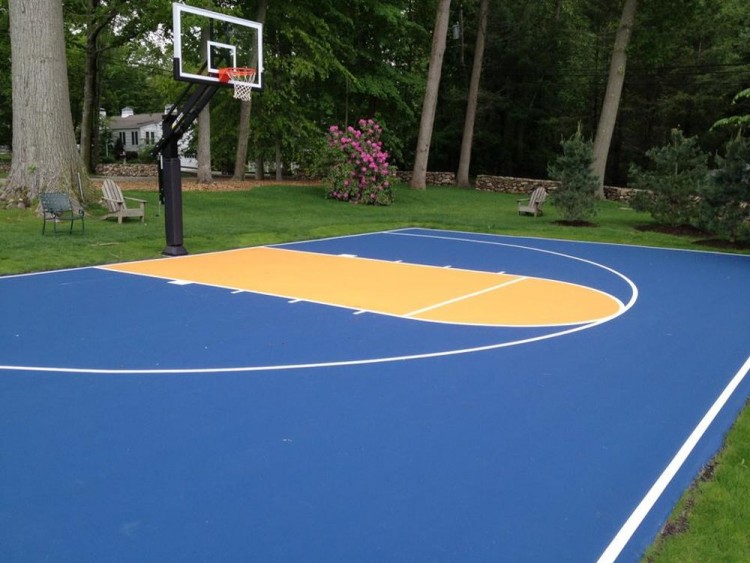
Sidelines
The outer edge of the court is denoted by the sidelines, which run the length of the court. On a full-sized court they measure 28m.
Baseline and endline
The terms baseline and endline both refer to the ends of the court running behind the goals. Typically they measure 15m.
The use of the different terms depends on the direction a team is playing. Endline is the term for the end of the court which a team is defending, baseline is the for the attacking end.
Mid court
This is the halfway mark on the court and is used to denote the offensive playing area during a game.
On a full-sized court, the mid court line would be 14m from each endline.
Centre circle
Used for the opening tip off, the centre circle has a 3.6m diameter.
Three point line
The three point lines are the arcs that mark a range boundary from each hoop. Scoring from outside this line is worth three points. The distance of the line will vary depending on the level of game, but is typically 6. 75m from the basket.
75m from the basket.
Free throw line
The free throw line, marked 4.6m from the backboard, is the mark at which a player must stand when shooting free throws.
Free throw circle
The free throw circle is the same size as the centre circle (3.6m in diameter). Shooters must stay inside this circle when taking a free throw. The circle is also used for jump balls.
Free throw lane lines/key
Lane lines run from the free throw line to the baseline, to form the 'key'. The shape and width can vary depending on the level of the game, but FIBA (International Basketball Federation) regulation changes in 2010 set it as a 4.9m by 5.8m rectangle.
Some also include space markings to keep opposing players from obstructing the free throw shooter.
Basketball court lines in feet and yards
| Court marking | Dimensions (ft) |
| Sidelines | 91.86ft |
| Baseline and endline | 49.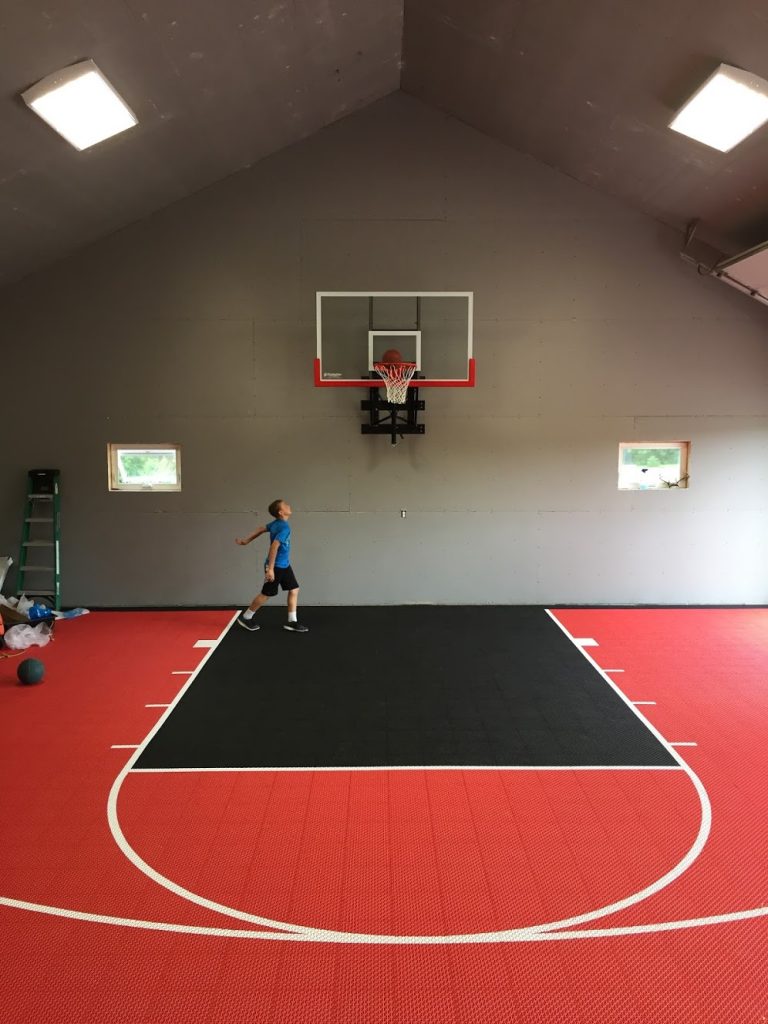 21ft 21ft |
| Mid court | 45.93ft |
| Centre circle | 11.81ft diameter |
| Three point line | 22.14ft from the basket |
| Free throw line | 11.81ft, 15.09ft from the backboard |
| Free throw circle | 11.81ft diameter |
| Free throw lane lines/key | 16ft x 19ft |
| Court marking | Dimensions (yds) |
| Sidelines | 30.62yds |
| Baseline and endline | 16.4yds |
| Mid court | 15.31yds |
| Centre circle | 3.93yds diameter |
| Three point line | 7.38yds from the basket |
| Free throw line | 3.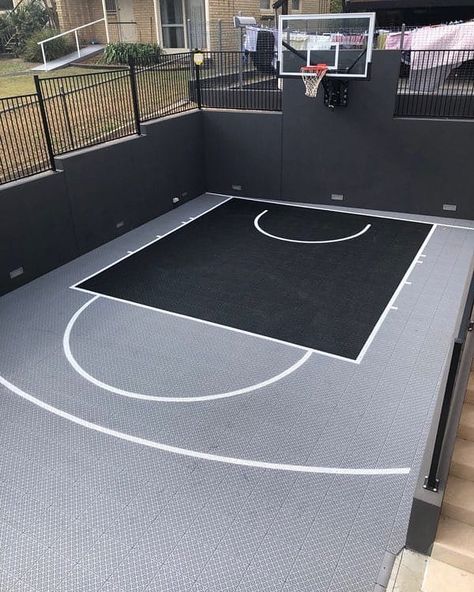 93yds, 5.03yds from the backboard 93yds, 5.03yds from the backboard |
| Free throw circle | 3.93yds diameter |
| Free throw lane lines/key | 5.33yds x 6.33yds |
Basketball goal dimensions
A number of basketball goal systems are available: wall hinged, ceiling mounted or free-standing practice goals.
Backboards
Backboard dimensions are 1.8m x 1.22m, with a minimum thickness of 19mm. Backboards can be made of either timber or transparent material and must be fitted with padding at all levels above U16.
Backboard line markings should be 50mm in width and either black or white, depending on the material of the board. The inner rectangle should measure 0.45m x 0.59m.
Goals
The basketball goal (also known as a ring or hoop) is typically 18 inches (45.72cm) in diameter and must be positioned 3.05m from the floor.
Nets are typically white and suspended from the ring.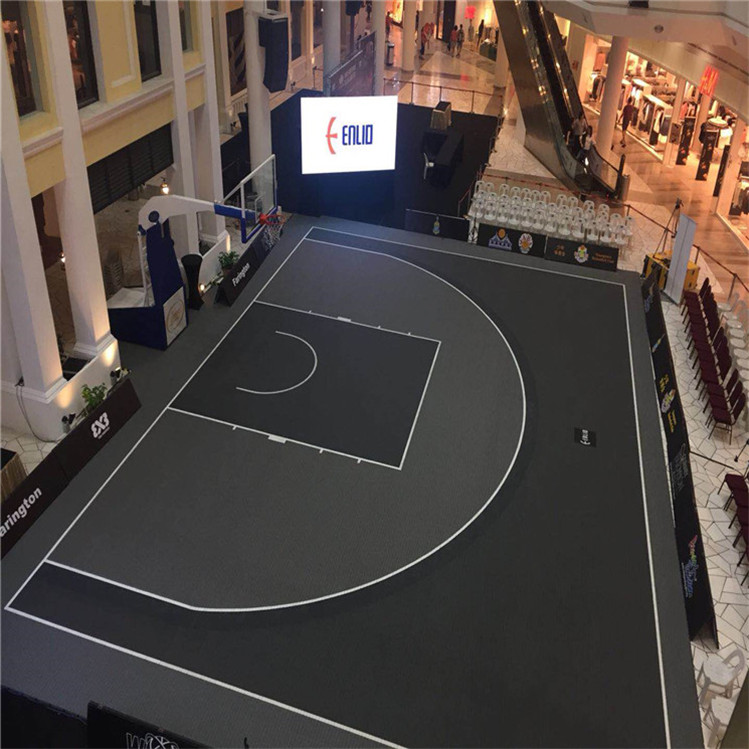 They should be no shorter than 45cm.
They should be no shorter than 45cm.
Download the PDF
The images and diagrams showing the dimensions of a basketball court in this article are available in a downloadable PDF
Check out our range of basketball equipment, including goals, backboards and accessories.
Related Posts
- Hockey field dimensions
- Rugby pitch dimensions
- Rugby league pitch dimensions
- Tennis court dimensions
Everything You Need to Know About Basketball Court Dimensions
Of the two major American-invented sports — baseball and basketball — only one has gained worldwide popularity. We play baseball across parts of the globe, but we play basketball worldwide. You can play with as few as two people and as many as ten. Shoot hoops indoors and outdoors and on any surface hard or flat enough to bounce a ball.
Indoor courts are usually made from hardwood, though other, more easily-maintained surfaces are gaining in popularity.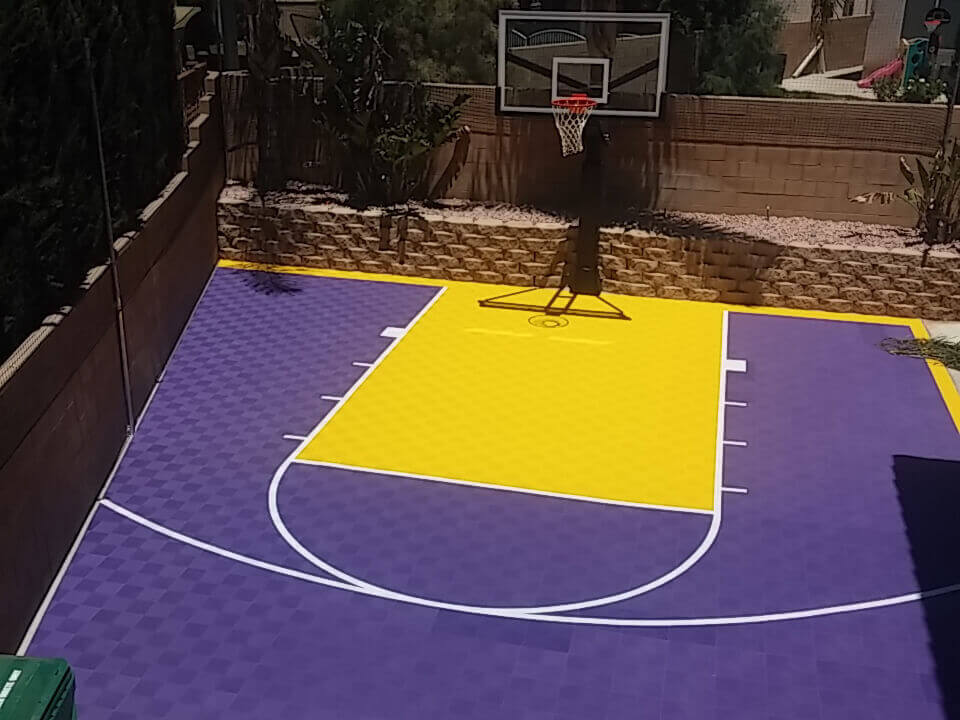 Outdoor courts can be either asphalt or concrete. You can put a permanent basketball court just about anywhere you would like. Don’t have the room for a full-length court? Fitting just a half court into your driveway, backyard, or commercial gym would be just as useful.
Outdoor courts can be either asphalt or concrete. You can put a permanent basketball court just about anywhere you would like. Don’t have the room for a full-length court? Fitting just a half court into your driveway, backyard, or commercial gym would be just as useful.
So, have a space in mind and wondering “What are the dimensions of a basketball court?” Let’s take a look at the standard sizes for every level of basketball, from high school all the way up through international competition.
NBA Basketball Court DimensionsThe National Basketball Association, better known as the NBA, boasts the largest court dimensions of any level of basketball — domestic or international. The outer dimensions are 94 feet long by 50 feet wide. The half court line is, as the name would suggest, halfway between each end line. In the middle of the half court line is a tip-off circle with a six-foot radius, which often sports the home team’s logo.
The key is 16 feet wide and 19 feet from the baseline to the foul line.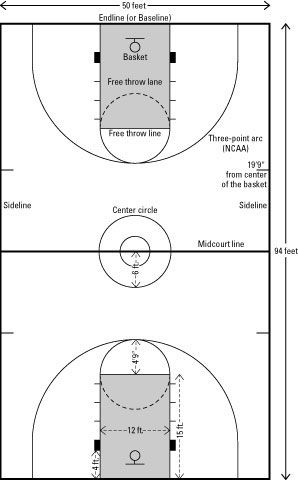 A semicircle with a six-foot radius extends from the foul line. Some courts have the other side of the half-circle drawn in a dotted line inside the key to complete the circle and create a clear boundary for any jump balls.
A semicircle with a six-foot radius extends from the foul line. Some courts have the other side of the half-circle drawn in a dotted line inside the key to complete the circle and create a clear boundary for any jump balls.
The backboard protrudes four feet out from the baseline, and the rim of the basket hangs 10 feet off the ground. Subtracting the four feet overhang from the 19-foot length of the key, we get the familiar 15-foot distance from the foul line to the front of the backboard. It’s a misconception that the foul line is 15 feet from the center of the basket. The backboard itself measures six feet wide and 42 inches high.
Inside the key, a four-foot arc is aligned with the center of the basket to designate the restricted arc. If a defender is inside this semicircle, he cannot draw a charging foul. Along both sides of the key, lines are drawn three feet apart to create the standing positions for other players during a free throw attempt, starting with a box that is seven feet from the baseline and one foot wide.
Outside the key, the three-point line forms an imperfect arc stretching one side of the baseline to the other. The arc isn’t a perfect circle because it would run out of bounds on the sides of the court.
Instead, the three-point line runs in a straight line from the baseline out 16 feet, nine inches, at which point the line begins to curve. The straight lines are an even 22 feet from the center of the basket, and on the arc, the distance is 23 feet and nine inches.
Starting at the baseline and running 28 feet toward the center of the court, a line bounds the team bench area. The line also acts as the starting place for inbounds passes after timeouts and fouls.
WNBA Basketball Court DimensionsThe Women’s National Basketball Association or WNBA’s court dimensions are identical to the NBA court in every way except the three-point line. Instead, the distance is equal to the International Basketball Federation (FIBA) at 22.15 feet from the center of the hoop. WNBA teams share arenas and playing surfaces with the NBA, which is why it’s no wonder the court dimensions are so similar.
WNBA teams share arenas and playing surfaces with the NBA, which is why it’s no wonder the court dimensions are so similar.
NCAA Basketball Court DimensionsNational Collegiate Athletic Association or NCAA basketball courts have similar dimensions to the NBA and WNBA, which include the:
- Court
- Foul line
- Backboard
- Basket height
- Tip-off circle
That said, there are a few significant differences in the dimensions of the NCAA court. For starters, the key is only 12 feet wide, rather than 16. The first box on the side of the key is only six feet from the baseline, not seven. The restricted area under the basket is also one foot smaller, at three feet in diameter rather than the NBA’s four.
However, the most recognizable difference between the NBA’s court dimensions and the NCAA’s is the distance of the three-point line. The NCAA three-point line is only 20 feet, nine inches from the center of the basket.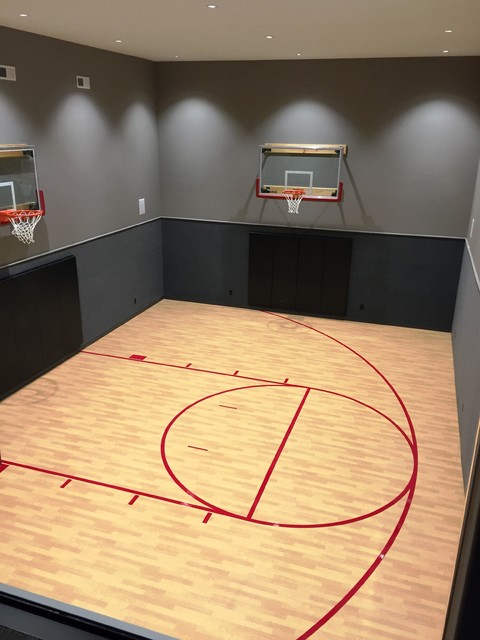 Because of the smaller diameter, it is a continuous arc from one side of the baseline to the other, with no straight lines necessary to create space on the sidelines.
Because of the smaller diameter, it is a continuous arc from one side of the baseline to the other, with no straight lines necessary to create space on the sidelines.
The difference in three-point line distances is the biggest adjustment for shooters to make as they begin their professional careers, and also why it’s so difficult to project how well a player will shoot in the pros.
High School Basketball Court DimensionsHigh school basketball courts are a little different from their college and professional counterparts. The most noticeable difference is that the court is a full 10 feet shorter, measuring only 84 feet. However, there are some similarities. The court is still 50 feet wide. The basket is also 10 feet off the ground.
The tip-off circle has a six-foot radius, just like the big kid courts, and while the high school landscape isn’t as standardized as college and professional basketball, the backboard is supposed to have the same measurements as the NCAA and NBA.
Just as in college and professional basketball, the foul line is 15 feet from the backboard, and the key is 19 feet long. It’s also the same 12 feet wide as the NCAA — four feet narrower than the NBA and WNBA.
The other visible difference is the distance from the three-point line. Shorter than either the NCAA or NBA, the high school free throw line is just 19 feet, nine inches from the center of the basket. Additionally, high school basketball courts do not have any restricted area under the basket, since that rule doesn’t exist in high school basketball.
FIBA Basketball Court DimensionsFIBA governs international basketball courts. The measurements for FIBA basketball courts differ from U.S. courts because of the difference between our Imperial measurements — feet and inches — and the more standard metric system.
FIBA courts are an even 28 meters long, which converts to almost 92 feet. The 15-meter width converts to just over 49 feet.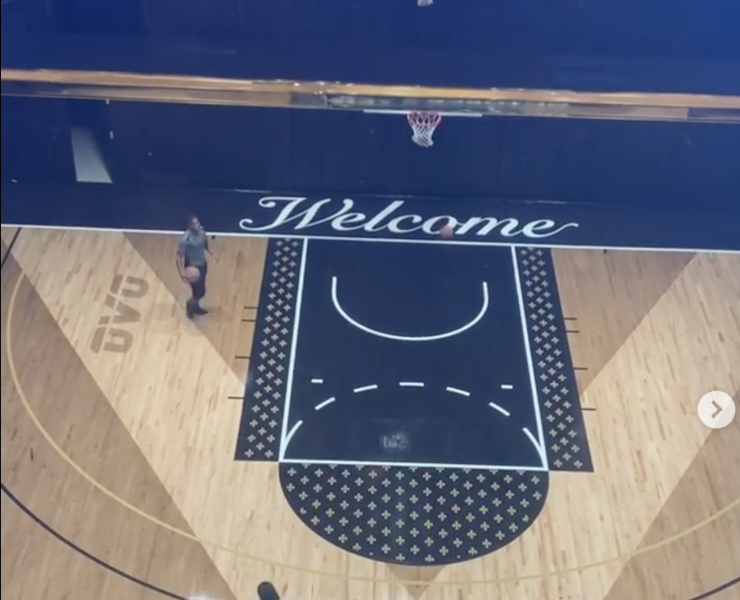 The tip-off circle is a bit smaller as well, at 3.5 meters in diameter. This difference translates to a radius of about five feet, seven inches.
The tip-off circle is a bit smaller as well, at 3.5 meters in diameter. This difference translates to a radius of about five feet, seven inches.
The key is almost the same size at 5.8 meters long and 4.8 meters wide. These numbers convert to within a few inches of 19 and 16 feet. The basket is 1.2 meters, or almost four feet, in from the baseline, which puts the foul line at 4.6 meters — 15 feet — away. The restricted area under the basket is 1.25 meters or just a shade more than four feet in radius.
The basket is still 10 feet off the ground, which means the biggest difference is the three-point line. At the top of the arc, the three-point line is 6.75 meters from the center of the basket or 22.15 feet. This measurement works out to about 22 feet, two inches. The FIBA three-point line, which has also been adopted by the WNBA, is over a foot and a half closer than the NBA line.
The History of Basketball Court DimensionsSince its invention in 1891, basketball’s court dimensions have varied.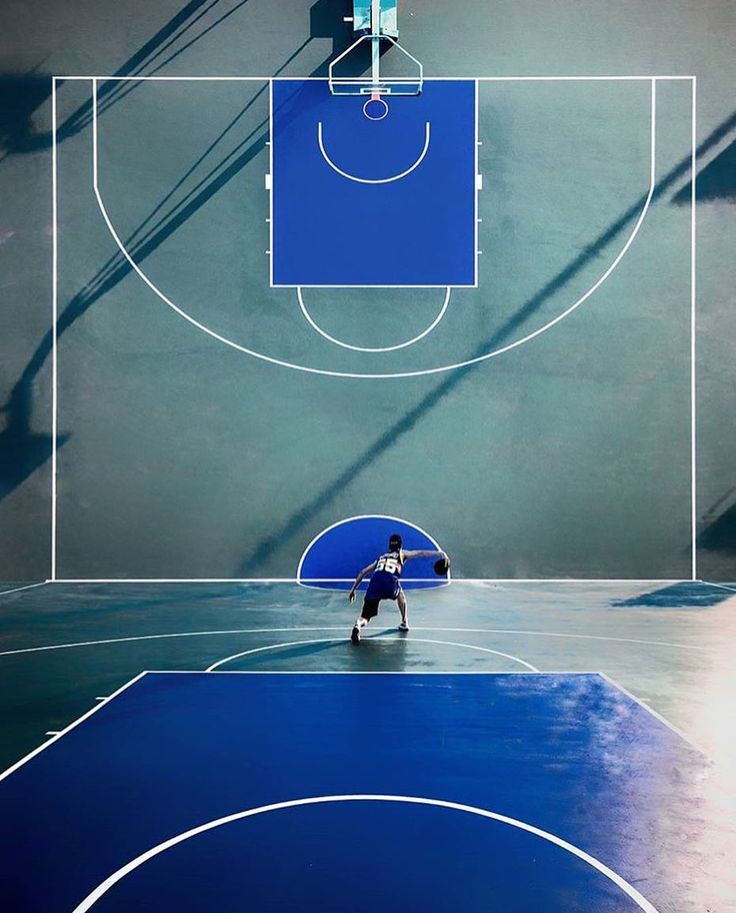 Let’s look at some of its historical changes, as well as answering that nagging question — “Why are basketball hoops 10 feet high?” — below:
Let’s look at some of its historical changes, as well as answering that nagging question — “Why are basketball hoops 10 feet high?” — below:
The Story Behind the 10-Foot High Hoop
It would appear the 10-foot basketball hoop is the result of a careful calculation that considers the human anatomy and mechanics of the game. After all, even the tallest players today have to jump to dunk a ball, and a ten-foot high rim gives a comfortable target to shoot for at a distance. But as we see so often in history, the truth is much more mundane.
When James Naismith dreamed up the game in Springfield, MA in 1891, the railing he chose to hang the baskets on was ten feet off the ground. So, while everything else about the sport has changed since that first game, the baskets are still right where Dr. Naismith hung them.
The History of the Three-Point Line
The three-point line is arguably the most recognizable aspect of a basketball court’s dimensions and part of the reason why is attributed to the history surrounding this semicircle.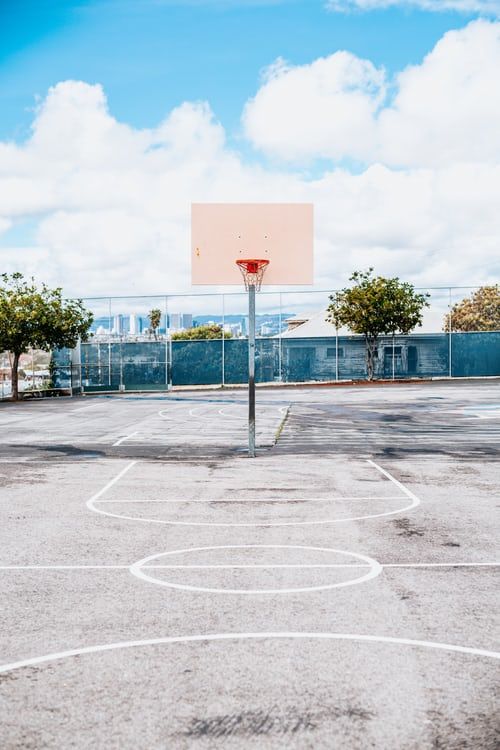
The first instance of the three-point line appeared in the American Basketball League in 1961, a full 70 years after Dr. Naismith invented the game. The line was added to increase excitement, but the league folded in just one and a half seasons, so the idea never had a chance.
In 1967, the next competitor to the NBA arrived. The American Basketball Association, or ABA, instituted the three-point line from the very start, and it was a huge success. The ABA had many exciting innovations that produced a better product for the fans. But ultimately, there was not enough room for two professional basketball organizations, so the NBA and ABA merged in 1976.
The three-point line, however, was not included in the merger! The decision-makers in the NBA at the time were too stubborn to adopt such a radical change. They held out for three years before implementing the three-point line in the 1979-1980 season. The NCAA didn’t integrate it until 1986, and it didn’t arrive on high school basketball courts until 1987.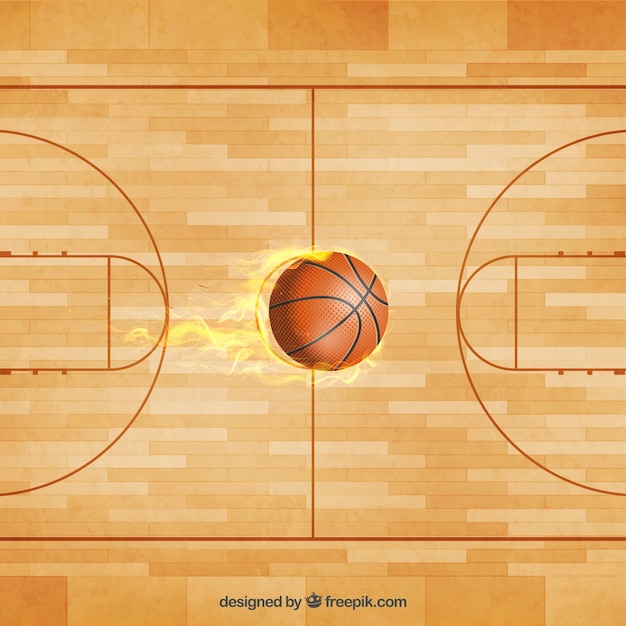
That isn’t the end of the story, however. The line was moved closer for three seasons in the ‘90s to try to boost scoring, but it was quickly moved back to its original place. Taking the idea to the extreme, the NBA has even admitted to having discussions about a four-point line. Ultimately, we’ll believe it when we see it.
The Original Cage Matches
In the early days of professional basketball, the game was played inside an actual cage. The reasons were more about practicality than about safety. The rule for who got to inbound a ball that left the court was “whoever got to it first,” so organizers took to putting up a cage so the ball could never go out of bounds in the first place.
Those first basketball courts were about a third smaller than they are today, and the cages provided a physical boundary and an extra immovable for savvy teams. Could you imagine how much different the game of basketball would be today if those cages had stuck around?
The Alternative Key Designs
Today, basketball courts at all levels share a common design for the key — a rectangle measuring either 19 feet by 16 feet or 19 feet by 12 feet.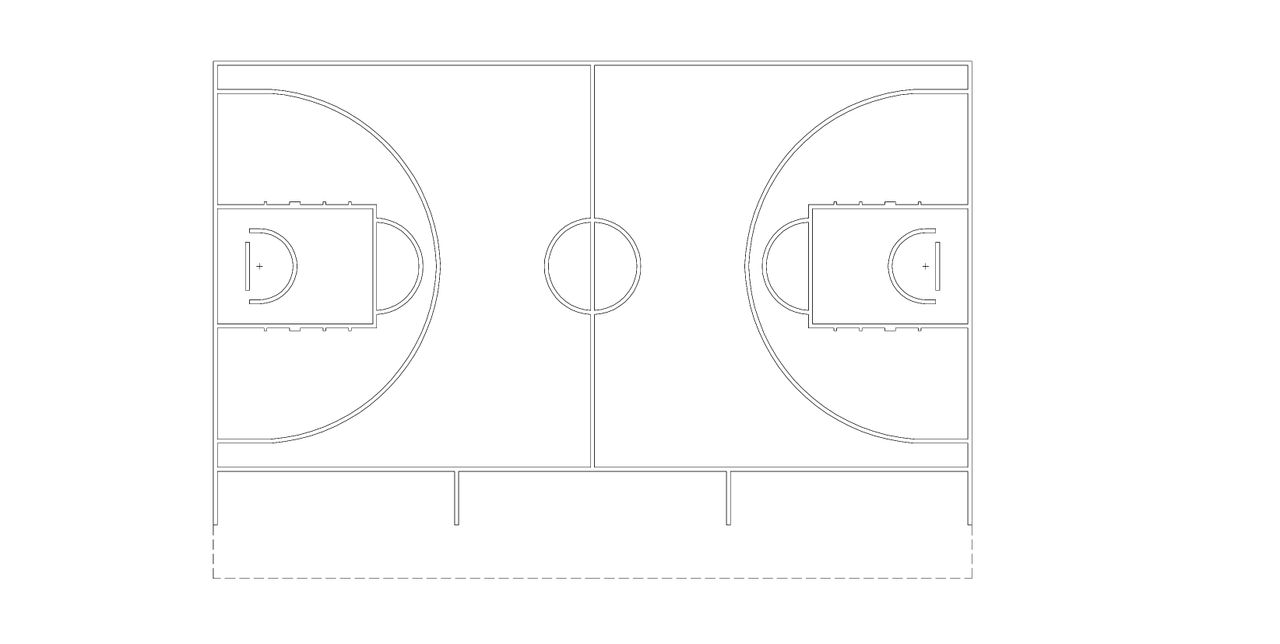 However, this was not always the case. From the creation of FIBA in 1956 until 2010, the key was a trapezoidal design that was significantly wider at the baseline.
However, this was not always the case. From the creation of FIBA in 1956 until 2010, the key was a trapezoidal design that was significantly wider at the baseline.
Another design of this feature is responsible for the name “key.” Have you ever thought about how a rectangular area under a basket got such a random name?
The reason is that the original area was much narrower, while the circle surrounding the free throw line was the same size. These two factors combined to create a shape that resembled an old-fashioned key. In 1951, the key was widened to 12 feet and later to the 16 feet we see now in the NBA and FIBA.
While the term lives on, time has erased any record of its design and original reference. And for the record, the official name for this feature is “free throw lane,” which isn’t a phrase many of us hear often.
And that’s a wrap on the history of basketball’s court dimensions.
Build Your Basketball Court With PROformancePerhaps you don’t have 94 feet of flat asphalt or indoor floor space. Don’t worry, because residential half court setups can be just as fun. And whether you are looking to paint your court or apply a pre-made solution, sticking to the official dimensions will take your pickup games to the next level.
Don’t worry, because residential half court setups can be just as fun. And whether you are looking to paint your court or apply a pre-made solution, sticking to the official dimensions will take your pickup games to the next level.
Take a look at our selection of goals, nets and accessories to bring your home’s court together. You’ll have a hard time dragging your kids off the court as they spend hours posting up like Boogie, slashing like LeBron and launching it from deep like Steph.
Basketball court markings: standards and norms
Author of the article
Khvatkov Dmitry
Consultant in the production of rubber coatings
Basketball field marking requirements are approved by the FIBA standard. The site must be flat with a hard surface, free of bends, cracks and other obstacles. The accepted dimensions of the field are 28 m long and 16 m wide. By NBA standards, the field is slightly larger: 28.7 m (94' ft) long and 15.3 m (50' ft) wide.
Areas not intended for international competitions may differ from accepted standards (for public use, in schools or universities, etc.) and usually vary from 20 to 28 m in length and from 12 to 16 m in width.
Basketball Court Marking Standards
Basketball court markings are conventionally divided into 5 components:
- Boundary lines. They are located along the perimeter of the site and set its size. The lines that run along the field are called side lines, and those that are behind the baskets are called front lines.
- Central line. Divides the court in half parallel to the front lines.
- Central zone. It is a circle and is placed in the middle of the center line, and, accordingly, in the center of the entire field.
- Three-point line. It is a semi-ellipse and is located around the shields on both sides of the field. It limits the close range.
- Free throw line. It is located in front of the boards parallel to the front line and is limited on the sides by paint lines.

The standard line width is 5 cm. All outlines and lines must be of the same color (usually white) and be clearly visible from anywhere on the court.
Common lines
Common lines are used to limit the playing area of the court. The side lines (along the field) according to FIBA standards should be 28 m long, and the front lines - 16 m. For public areas, deviations from the accepted standards are allowed. Typically, basketball courts in schools or gyms are made from 20 m long and 12 m wide.
Central lines
The center line is parallel to the front and divides the field exactly in half. According to the standards - it should extend beyond the side lines by 15 cm on both sides.
In the middle of the center line there is a circle with a diameter of 3.6 m, which limits the central zone of the field. In this zone, the ball is played at the beginning of the game.
Three-Point Line
Three-Point Lines are located around the backboards on both sides of the field and consist of two straight lines 2. 9 long9 m and a semicircle. Straight lines run perpendicular to the front at a distance of 0.9 m from the side lines. Despite the fact that visually the distance from the ring to the side of the three-point line seems to be less than to its central part, the distance from the backboard to any point is 6.75 m.
9 long9 m and a semicircle. Straight lines run perpendicular to the front at a distance of 0.9 m from the side lines. Despite the fact that visually the distance from the ring to the side of the three-point line seems to be less than to its central part, the distance from the backboard to any point is 6.75 m.
Penalty lines
Penalty lines limit the nearest area at the backboard. They consist of a trapezoid and a free throw zone.
Despite the name, the "trapezium" is a rectangle (until 2009year it really was a trapezoid), which is located under the shield. Its dimensions are 5.8 meters long and 4.9 meters wide. The shield is located at a distance of 1.575 m from the end line in the middle of the court. In front of the backboard, at a distance of 1.25 m, there is a semicircle that limits the area for picking up the ball.
At a distance of 4.225 meters from the backboard, the trapeze zone ends and the free throw zone begins. It is a semicircle with a diameter of 3. 6 m (like the central circle).
6 m (like the central circle).
Paint zone lines
These lines are serifs on both sides of the trapezoid (parallel to the side lines). They limit the areas for players who are fighting for the ball during a free throw.
Zones on the basketball field
The basketball court is divided into zones using markings. Each zone has its own specific rules.
Center circle
The center circle is used as a separate kick-off area at the start of the game. One representative from each team stand in a circle from their side and fight for the ball in a jump, after it is dropped by the referee. All players are exclusively on their side of the field, except for one who rebounds on the opponent's side.
Neutral zone
The peculiarity of this zone is that as soon as the player of the attacking team with the ball crosses the center line and is on the side of the opponent, he cannot pass the ball to the player of his team who is on the other side of the field (i.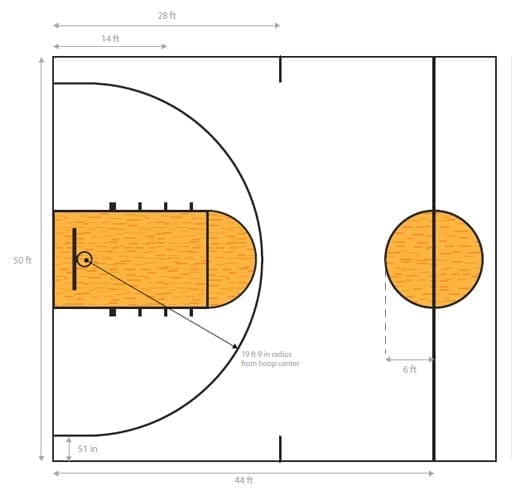 e. behind center line on your side).
e. behind center line on your side).
Three-point zone
The three-point line limits the near zone of the shot. Hitting the basket from outside the basket brings the team three points. If the throw was made inside the zone, then it brings two points.
Three-second zone
This is the zone in close proximity to the ring. It is called three-second, since the player of the attacking team cannot be in it for more than three seconds. Most balls are thrown in this zone, so when attacking, it provides maximum protection.
Free throw area
In controversial situations, a free throw is provided from this area. The player of the attacking team must score the ball without stepping over the line of the trapezoid. At the same time, the players of both teams are not in the three-second zone. They take up positions along the paint lines on the sides of the trapezoid and may not step outside the lines until the free throw shooter has shot the ball.
How to mark a basketball field?
Basketball field markings, whether it is an international competition court or an open-air amateur field, are best applied using special equipment. This will ensure the long life of the coating, the lines will not clog and will promote fair play.
This will ensure the long life of the coating, the lines will not clog and will promote fair play.
You can order the marking of a basketball court in Moscow and the Moscow region from Rezkom. We will measure the premises and develop a design project for the field so that it complies with generally accepted rules and is convenient for operation. For more details, you can contact our manager by phone 8-495-64-24-111.
History of world basketball and history of basketball in Russia
replica Swiss watches
Basketball (English basket - basket, ball - ball) is one of the most popular team sports in the world. Basketball is played by two teams, each consisting of five players. The goal of each team is to throw the ball with their hands into the opponent's net ring (basket) and prevent the other team from taking possession of the ball and throwing it into their own basket. The basket is at a height of 3.05 meters (10 feet) from the floor. There are 5 people from each team on the court, in total there are 12 people in the team, substitutions are not limited. For a ball thrown from close and medium distances, 2 points are counted, (because of the three-point line) - 3 points. A free throw is worth one point. The standard size of a basketball court is 28 meters long and 15 meters wide. Basketball is one of the most popular sports in the world.
For a ball thrown from close and medium distances, 2 points are counted, (because of the three-point line) - 3 points. A free throw is worth one point. The standard size of a basketball court is 28 meters long and 15 meters wide. Basketball is one of the most popular sports in the world.
Basketball around the world
In the winter of 1891, students at the Youth Christian Association College in Springfield, Massachusetts, forced to perform endless gymnastic exercises, considered at that time almost the only means of introducing young people to sports, were very bored in physical education classes. It was necessary to put an end to the monotony of such activities, to introduce a fresh stream into them, which would be able to satisfy the competitive needs of strong and healthy young people.
College teacher James Naismith found a way out of a seemingly dead-end situation. On December 1, 1891, he tied two peach baskets to the railing of the balcony of the sports hall and, dividing eighteen students into two teams, offered them a game, the meaning of which was to throw more balls into the opponents' basket.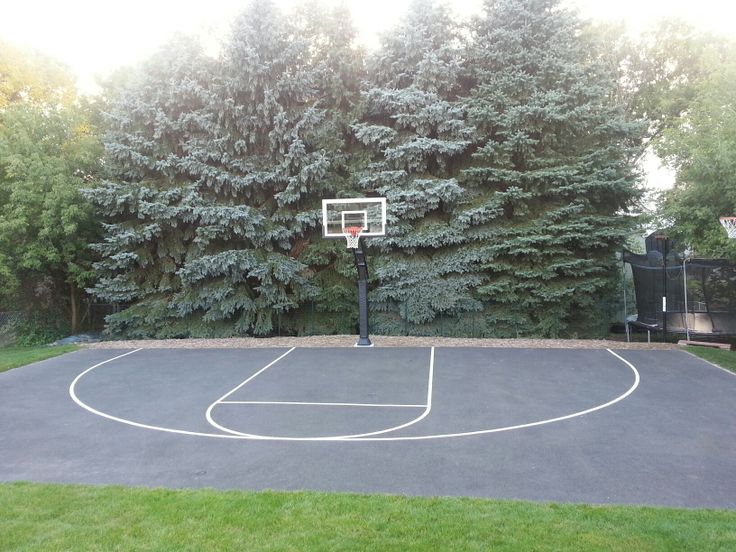
The idea of this game originated in his school years, when children played the old game "duck-on-a-rock". The meaning of this game, popular at that time, was as follows: throwing a small stone, it was necessary to hit the top of another stone, larger in size, with it.
Quite pragmatically called "basketball" game only remotely resembled modern basketball. There was no dribbling, the players only threw it to each other, standing still, and then tried to throw it into the basket, and only with both hands from below or from the chest, and after a successful throw, one of the players climbed onto a ladder attached to the wall and removed the ball from the basket . From a modern point of view, the actions of the teams would seem to us sluggish and inhibited, but the goal of Dr. Naismith was to create a team game in which a large number of participants could be involved at the same time, and his invention fully met this task.
Very quickly, starting in 1895, basketball from the USA penetrated first to the East - to Japan, China, the Philippines, as well as to Europe and South America.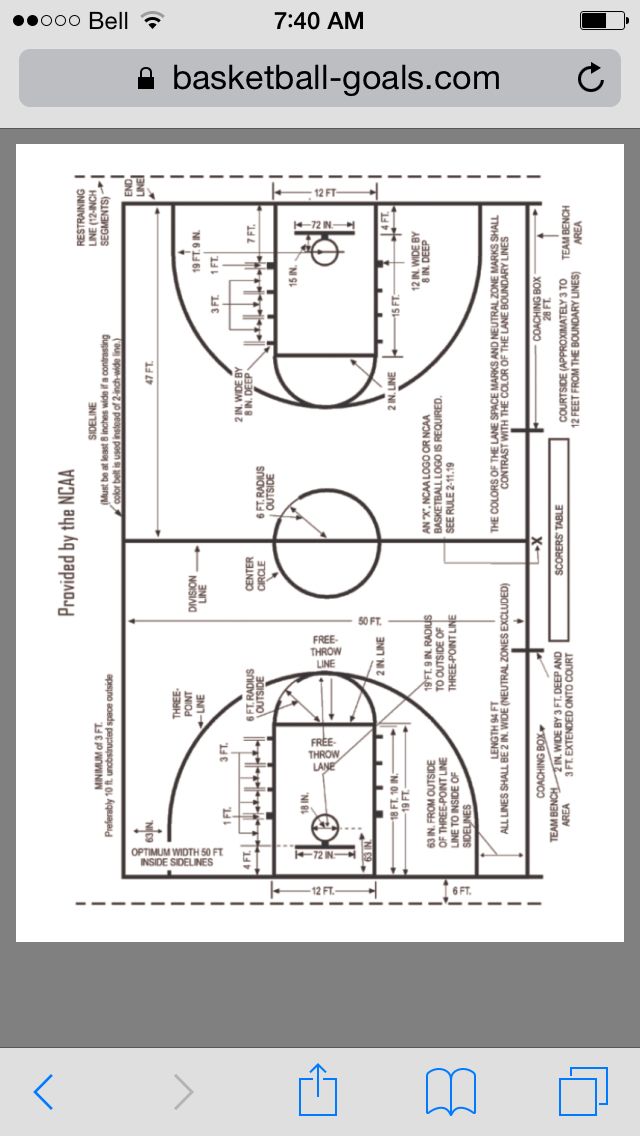
In 1904, at the Olympic Games in St. Louis (USA), the Americans organized an exhibition tournament between teams from several cities. Similar demonstration tournaments were held at the 1924 (Paris) and 1928 (Amsterdam) Olympics.
Basketball associations were created in a number of countries, but organizational disunity hindered international contacts and hindered the further development of basketball. June 18 1932 in Geneva, the first international conference of national basketball associations took place. The meeting decided to establish the International Federation of Basketball Associations (FIBA). The first international rules of the game were adopted in 1932 at the first FIBA Congress, after which they were repeatedly adjusted and changed, the last significant changes were made in 1998 and 2004.
In 1935, the International Olympic Committee decided to recognize basketball as an Olympic sport.
Basketball made its Olympic debut at the XI Olympic Games in Berlin in 1936.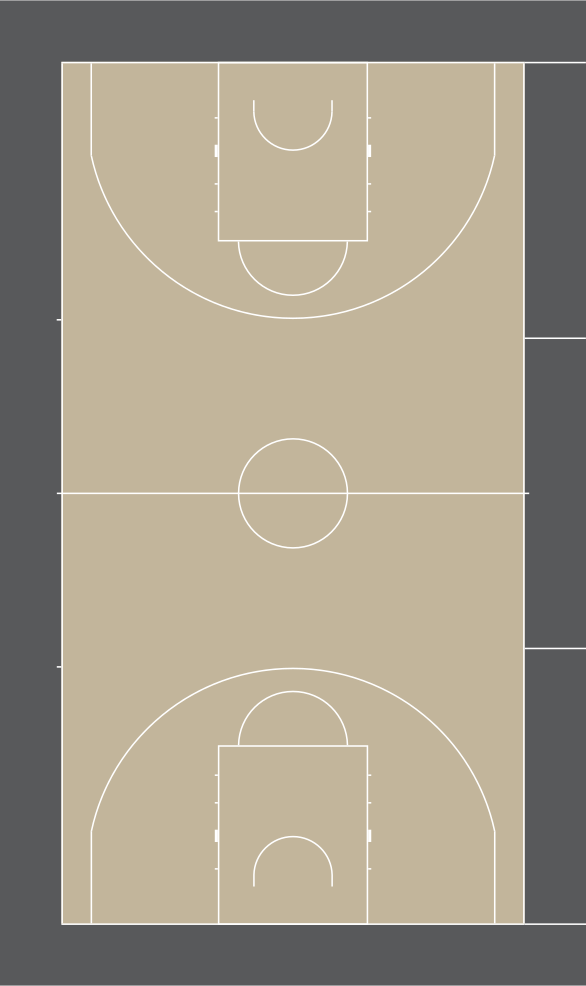 Men's teams from 21 countries took part in the tournament. Competitions were held in open areas, all subsequent Olympic tournaments were held indoors. The USA team became the first Olympic champion.
Men's teams from 21 countries took part in the tournament. Competitions were held in open areas, all subsequent Olympic tournaments were held indoors. The USA team became the first Olympic champion.
The debut of women's basketball at the Olympic Games took place in 1976 in Montreal. Six teams participated in the tournament. The first Olympic champions were the basketball players of the USSR national team, who became champions twice more. The first European Championship among men was held at 1935 in Geneva. Latvian basketball players won. The first European Women's Championship was held in Rome in 1938, which was won by Italian basketball players.
The decision to hold the world championships among men was taken at the FIBA congress during the 1948 Olympics. in London. The first World Basketball Championship took place in 1950. in Buenos Aires (Argentina). 10 teams took part in the championship. The first world champion was the team of Argentina, who defeated the 1948 Olympic champion team of the United States.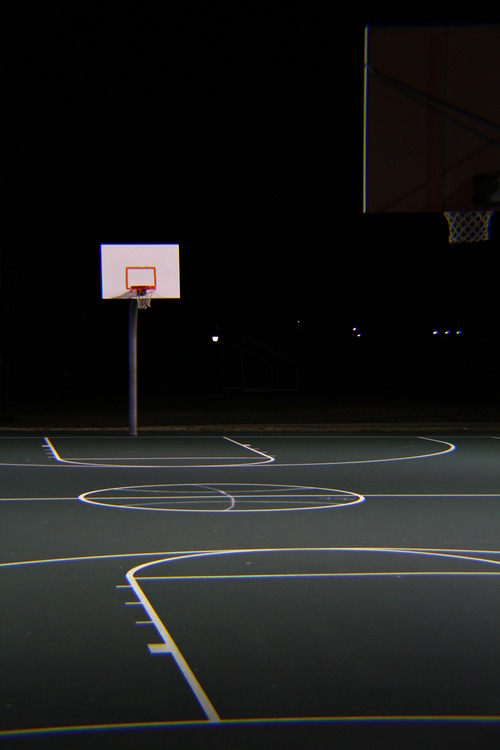
At the FIBA congress in Helsinki, in 1952 (during the Olympic Games), it was decided to hold the Women's World Championships. The first championship was held in 1953 in Santiago (Chile), and the first champions were American basketball players.
Thus, the game, which was once invented just for the sake of diversifying the physical education lessons of students, has become one of the most popular and massive sports games in the world. With the development of the Game, its rules were changed and supplemented, as well as the equipment and layout of the site (for example, the introduction of a time limit (24 seconds) for an attack by the team of the opponent's basket, or the appearance of a line, for hitting due to which the team is awarded 3 points (1984)).
Basketball in Russia
Basketball in Russia was born in 1906. Place of birth - St. Petersburg, sports society "Mayak".
The gymnasts of this society created the first basketball teams, then the teams appeared in the "Bogatyr" society, and some others.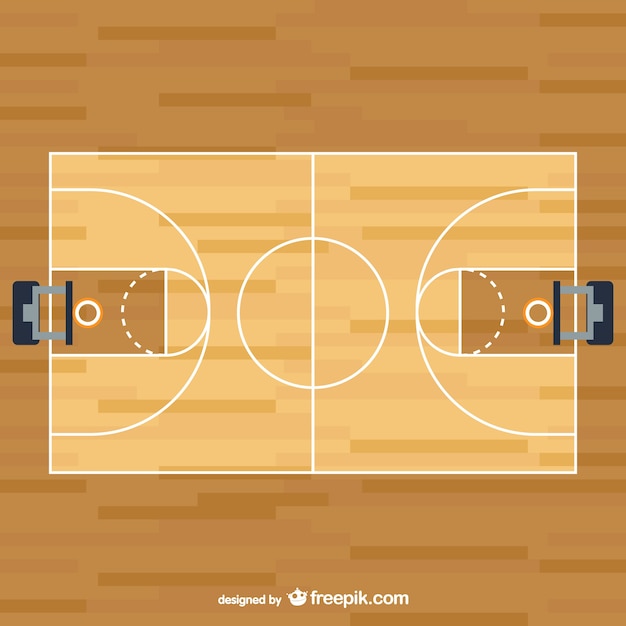 But before the October Revolution of 1917. this game was cultivated practically only in the capital of Russia - Petersburg. The new life of basketball in Russia begins in the early twenties. As an independent subject, basketball is introduced first at the Main Military School of Physical Education of Workers, and a little later at the Moscow Institute of Physical Culture.
But before the October Revolution of 1917. this game was cultivated practically only in the capital of Russia - Petersburg. The new life of basketball in Russia begins in the early twenties. As an independent subject, basketball is introduced first at the Main Military School of Physical Education of Workers, and a little later at the Moscow Institute of Physical Culture.
Graduates of these educational institutions became the first specialists in basketball in our country.
The basketball tournament held in 1923 is considered to be the first championship of the country. at the first All-Union Physical Culture Festival. In the same 1923 appeared in the USSR and the first official rules.
In 1947, the All-Union Basketball Section became a member of the International Basketball Federation. Soviet basketball players received the right to participate in all competitions organized by FIBA. In the same year, the USSR national men's team took part in the European Championship.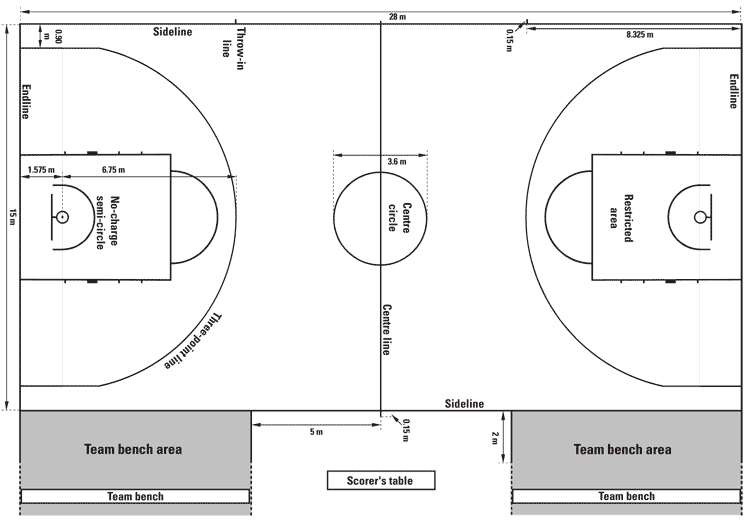 Our basketball players defeated the teams of Yugoslavia, Hungary, Bulgaria, Egypt, Poland and met in the final with the European champion - the team of Czechoslovakia. Having won with a score of 56:37, the USSR national team won the title of European champion.
Our basketball players defeated the teams of Yugoslavia, Hungary, Bulgaria, Egypt, Poland and met in the final with the European champion - the team of Czechoslovakia. Having won with a score of 56:37, the USSR national team won the title of European champion.
The USSR men's team was one of the strongest teams in the world during the 1950s, 1960s, 1970s and 1980s.
In total, in the final stages of 39 tournaments (9 Olympiads, 9 World Championships and 21 Europeans) from 1947 to 1990, in which the USSR team took part, only at the very first World Cup in 1959, the Soviet team failed to get into the number winners, and even then only for political reasons, the team was deprived of gold, since despite the fact that the USSR team won all its matches, it refused to play with the Taiwanese team. Such a unique achievement has not been conquered by any other basketball team.
Here is a complete list of the historical achievements of the USSR men's team:
Olympic champion (2): 1972, 1988.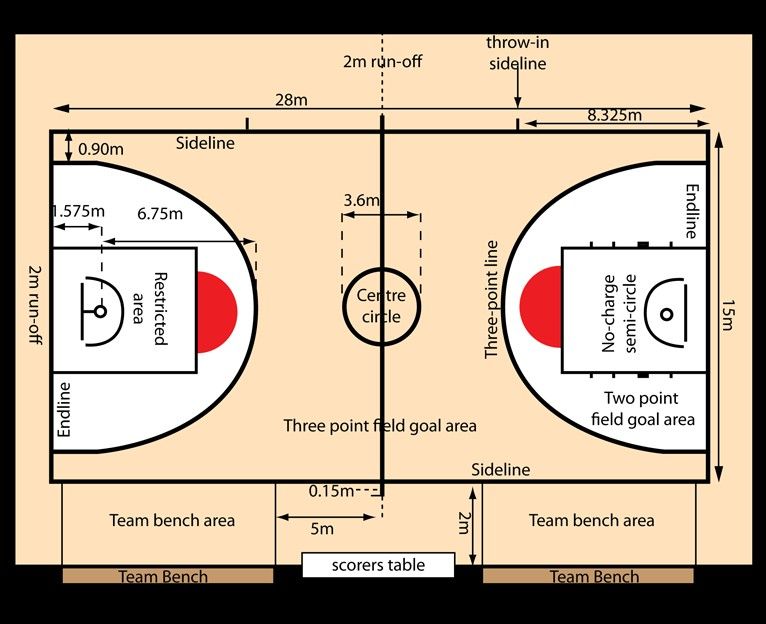
Olympic silver medalist (4): 1956, 1960, 1964, 1968
Olympic bronze medalist (3): 1968, 1976, 1980
World Champion (3): 1967, 1974, 1982
Vice World Champion (3): 1978, 1986, 1990
European Champion (14): 1947, 1951, 1953, 1957, 1959, 1961, 1963, 1965, 1967, 1969, 1971, 1979, 1981, 1985 (From 1957 to 1971, the USSR national team won 8 European Championships in a row).
The performance of the USSR women's team on the international arena looks no less impressive:
The USSR national team - 21 times became the champion of Europe (1950-1956, 1960-1991)
6 times the USSR national team held the title of World Champion (19649, , 1967, 1971, 1975 and 1983) and twice became the bronze medalist (1957 and 1986)
Three times the team became the Champion of the Olympic Games (1976, 1980, 1992 (under the flag of the united team)), in 1988 the USSR women's team became the bronze medalist of the Seoul Olympics.
The history of the Russian national teams, which are the official successors of the USSR national teams, dates back to 1992.